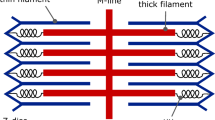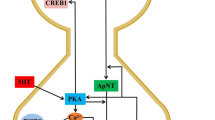Summary
Membrane potential and tension ofBusycon radular protractor muscles were studied by sucrose gap methods.
Excitation-contraction (EC) coupling was examined in response to acetylcholine (ACh) and high K which depolarized the fibres and induced tension, but without action potential firing. Potassium depolarization did not follow predictions expected from the Nernst equation at low and very high K levels, and maximum tension was found at about 100 mM K. EC coupling was very sensitive to [Ca]o. Ca-free media eliminated K- and ACh-induced tension but with normal depolarization, showing full electromechanical uncoupling.
Ionophore A23187 enhanced K- and ACh-induced responses and X-537A enhanced ACh responses, demonstrating acute dependence of activation on [Ca]o in this muscle. The calcium antagonists nifedipine and nisoldipine reduced tension in the muscle only at very high concentrations, and both agents slightly reduced K- and ACh-induced depolarization.
Verapamil reduced K- and ACh-induced tension but paradoxically it enhanced the depolarizing actions of these agents leading to electromechanical uncoupling. Abscisic acid (ABA) enhanced ACh- and K-induced tension and simultaneously enhanced their depolarizing actions. Ionophores and ABA appear to enhance calcium influx which may secondarily influence sodium influx.
Calcium antagonists have no consistent actions on this muscle, suggesting that calcium channel activity of the radular protractor may be different from that seen in mammalian visceral muscles.
Similar content being viewed by others
Abbreviations
- ABRM :
-
Anterior byssus retractor muscle
- ACh :
-
acetylcholine
- ABA :
-
abscisic acid
- EC :
-
excitation-contraction
- SR :
-
sarcoplasmic reticulum
- EGTA :
-
ethylene-diamine-tetraacetic acid
References
Antibiotic A23187 (1987) Review and bibliography. Calbiochem Catalogue, Behring Diagnostics, San Diego, Ca, USA
Brading AF, Burdyga TV, Scripnyuk ZD (1983) The effects of papaverine on the electrical and mechanical activity of the guinea pig ureter. J Physiol 334:79–89
Cheng JT (1976) Calcium-induced release of calcium in rectal smooth muscle of mice. Jpn J Pharmacol 26:73–78
Devore DI, Nastuk WL (1975) Effects of calcium ionophore X537A on frog skeletal muscle. Nature 253:644–646
Dorsett DA, Roberts B (1980) A transverse tubular system and neuromuscular junctions in a molluscan unstriated muscle. Cell Tissue Res 206:251–260
Fabiato A, Fabiato F (1979) Calcium and cardiac excitation-contraction coupling. Annu Rev Physiol 41:473–484
Glossman H, Ferry DR, Goll A, Rombusch M (1984) Molecular pharmacology of the Ca channel: evidence for subtypes, multiple drug receptor sites, channel subunits, and the development of a radioiodinated Ca channel label. J Cardiovasc Pharmacol 6:S608-S621
Godfraind T, Miller R, Wibo M (1986) Calcium antagonism and calcium entry blockade. Pharmacol Rev 38:321–416
Gogjian MA, Bloomquist E (1977) Calcium uptake by a subcellular membrane fraction of anterior byssus retractor muscle. Comp Biochem Physiol 58C:97–102
Hagiwara E, Nagai T (1970)45Ca movements at rest and during potassium contracture inMytilus ABRM. Jpn J Physiol 20:72–83
Hill RB (1958) The effects of certain neurohumors and of other drugs on the ventricle and radula protractor ofBusycon canaliculatum and on the ventricle ofStrombus gigas. Biol Bull 115:471–482
Hill RB (1970) Effects of postulated neurohumoral transmitters on the isolated radula protractor ofBusycon canaliculatum. Comp Biochem Physiol 33:249–258
Hill RB (1980) Use of an ionophore to maintain repeated caffeine contractures in holothurian muscle. Life Sci 27:1967–1973
Hill RB (1983) Effects of calcium antagonists on contraction of a holothurian muscle. Comp Biochem Physiol 76C:1–8
Hill RB, Licis P (1985) Lanthanum and caffeine affect both membrane responses and force in a molluscan muscle, the radula protractor ofBusycon canaliculatum. Comp Biochem Physiol 82C:363–376
Hill RB, McDonald-Ordzie PE (1979) Ionic dependence of the response to acetylcholine of a molluscan buccal muscle; the radula protractor ofBusycon canaliculatum. Comp Biochem Physiol 62C:19–30
Hill RB, Greenberg RJ, Irisawa H, Nomura H (1970) Electromechanical coupling in a molluscan muscle, the radula protractor ofBusycon canaliculatum. J Exp Zool 174:331–348
Hoyle G (1983) Muscles and their neural control. Wiley, New York, pp 193–222
Huddart H, Butler DJ (1986) Field stimulation responses of rat urinary bladder detrusor smooth muscle. Dependence upon slow calcium channel activity determined by K depolarization and Ca antagonists. Gen Pharmacol 17:695–703
Huddart H, Langton PD, Saad KHM (1984) Inhibition by papaverine of calcium movements and tension in the smooth muscles of rat vas deferens and urinary bladder. J Physiol 349:183–194
Huddart H, Hunt S, Oates K (1977) Calcium movements during contraction in molluscan smooth muscle, and the loci of calcium binding and release. J Exp Biol 68:45–56
Hunt S (1981) Molluscan visceral muscle fine structure. General structure and sarcolemmal organization in the smooth muscle of the intestinal wall ofBuccinum undatum. Tissue Cell 13:283–297
Kobayashi M (1972) Electrical and mechanical activities in the radula protractor of a mollusc,Rapana thomasiana. J Comp Physiol 78:1–10
Langton PD, Huddart H (in press) Voltage and time dependency of calcium mediated phasic and tonic responses in rat vas deferens smooth muscle — the effect of some calcium agonist and antagonist agents. Gen Pharmacol
Magaribuchi T, Nakajima H, Takenaga H, Kiyomoto A (1977) Effect of diltiazem on the transmembrane potential of isolated guinea pig taenia coli. Jpn J Pharmacol 27:319–322
Mangel AW, Connor JA, Prosser CL (1982) Effects of alterations in calcium levels on cat small intestine slow waves. Am J Physiol 243:C7–13
Reilly WM, Peretz B (1987) Excitation-contraction coupling in non-spiking smooth muscle in the gill ofAplysia. J Comp Physiol B 157:659–666
Sanger JW, Hill RB (1972) Ultrastructure of the radula protractor ofBusycon canaliculatum. Z Zellforsch 127:314–321
Sanger JW, Hill RB (1973) The contractile apparatus of the radula protractor muscle ofBusycon canaliculatum. Proc Malacol Soc London 40:335–341
Sawada M, Hara N, Ichinose M, Maeno T (1982) Excitatory and inhibitory effects of acetylcholine on the anterior aorta muscle ofAplysia. J Neurosci Res 7:179–192
Spedding M (1985) Calcium antagonist subgroups. TIPS 6:109–114
Sugi H, Atsumi S (1973) Localization of calcium accumulating structures in the ABRM ofMytilus edulis and their role in excitation-contraction coupling. Proc Jpn Acad 49:638–642
Syson AJ, Huddart H (1976) The effect of caffeine on excitation-contraction coupling in skeletal and smooth muscle. J Exp Biol 64:789–798
Tameyasu T, Sugi H (1976) Effect of acetylcholine and high external potassium ions on45Ca movements in molluscan smooth muscle. Comp Biochem Physiol 53C:101–103
Tattersall JEH, Brace RC (1987) Physiology and motor innervation of the supralateral radular retractor muscles of the pulmonate snail,Planorbarius corneus. J Comp Physiol A 160:115–125
Tsuchiya T, Kaneko T, Matsumoto J (1978) Calcium sensitivity of mantle muscle of squid. J Biochem 83:1191–1193
Twarog BM (1976) Aspects of smooth muscle function in molluscan catch muscle. Physiol Rev 56:829–838
Author information
Authors and Affiliations
Rights and permissions
About this article
Cite this article
Huddart, H., Hill, R.B. Electromechanical uncoupling in a molluscan muscle examined by the sucrose gap technique. J Comp Physiol B 158, 501–512 (1988). https://doi.org/10.1007/BF00691148
Accepted:
Issue Date:
DOI: https://doi.org/10.1007/BF00691148




